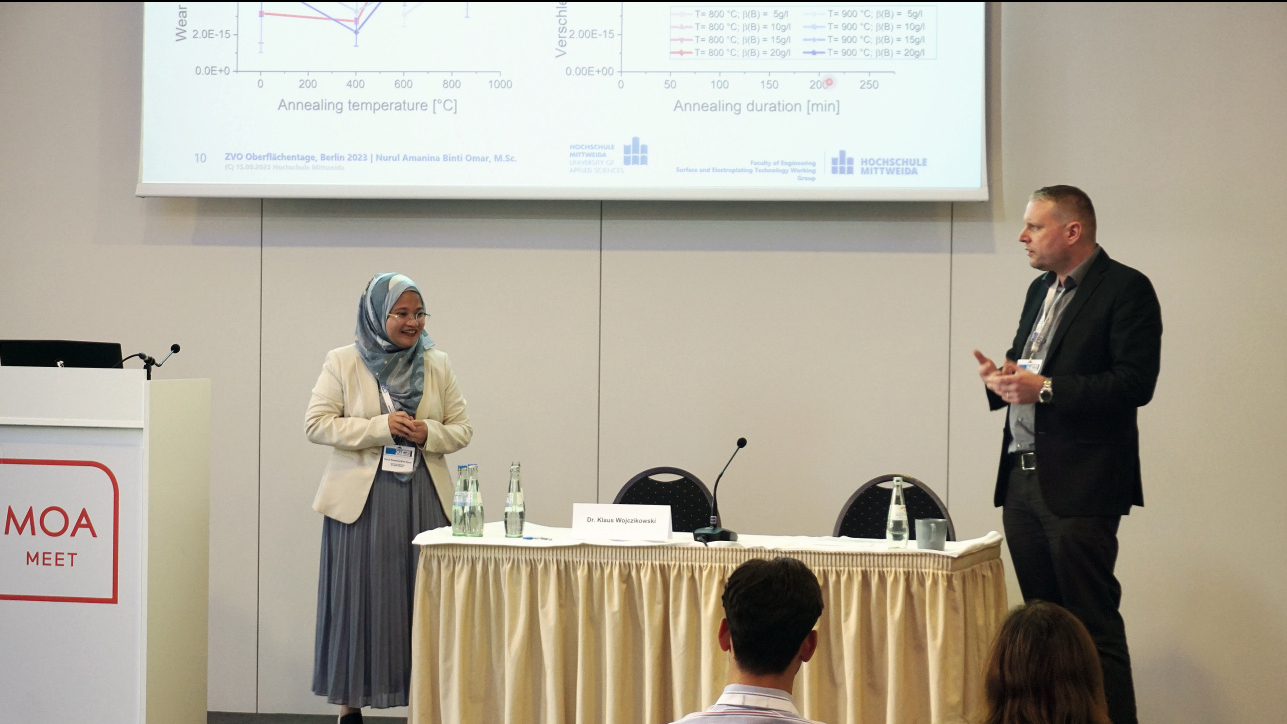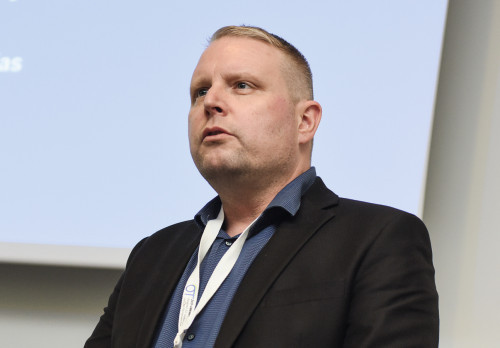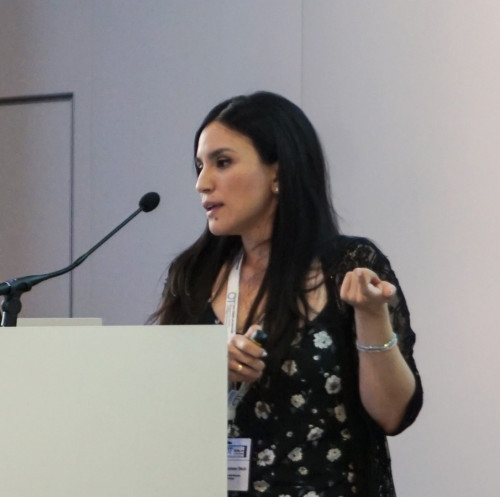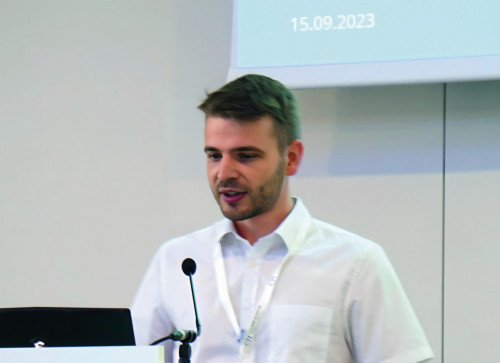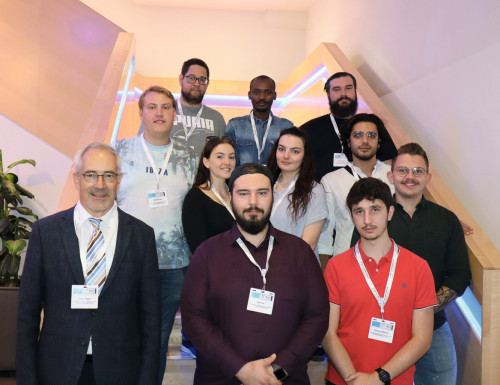The "Young Colleagues" lecture series has long provided a stage for young scientists at the Surface Days. Eleven speakers presented their topics in three lecture blocks. The lectures were very well attended. The audience switched between the topics in a lively manner, demonstrating their specific interest in the respective research areas. The young researchers were free to choose their topics - there was a strong focus on battery technology and other sustainable technologies. It wasn't just the young researchers from the universities who came, the young electroplating technicians from Gewerbliche Schule Schwäbisch Gmünd were also in Berlin with course director Volker Rogoll to get in touch with the industry.
Plasma electrolytic oxidation of aluminum
Claudia Albero Rojas from Chemnitz University of Technology reported on new findings in the field of plasma electrolytic oxidation of aluminum (PEO). The high voltages and thus extreme conditions in PEO make it possible to produce ceramic layers from mixed oxides of aluminum with zirconium. Among other things, the influence of complexing agents for zirconium on the bath stability and composition of the mixed oxide was investigated. Another focus was on the mechanical properties (crack toughness) of the naturally brittle ceramic layers.
Electroforming of aluminum
Philip Scherzl from HS Aalen spoke about the electroforming of aluminum and aluminum composite foils. He presented a patented (EP3114721B1) process for the single-stage, continuous production of composite foils that are used as battery electrodes. The TU Ilmenau is contributing to the project with its expertise in the field of aluminum deposition. Michael Kaupp, HS Aalen, also reported on this project ("KultBat") in a later lecture block, presenting analytical and performance data (battery tests) for the new materials.
Simulation of galvanic deposition
Stefan Daniel Schwöbel, a mathematician by training, has been working on the modeling and simulation of electrodeposition at Chemnitz University of Technology. It was shown that current models (direct current) are unsuitable for pulsed current deposition. For example, a consideration of limiting current densities using averaged current densities in pulse deposition leads to incorrect results. Stefan Daniel Schwöbel has shown impressive results of his own finite element models, which were implemented partly on commercial and partly on his own simulation tools.
Surface enlargement with metal foams
Battery electrodes were the subject of the presentation by Robin Arnet, HS Aalen. For current collection, these should have the highest possible specific surface area, which is currently achieved using metal foams, for example. In a new approach, fine-meshed plastic structures are 3D-printed, metallized and transformed into a hollow structure by removing the plastic. For the sake of simplicity, nickel plating was first attempted after applying a graphite coating. The goal is a coating with aluminum from ionic liquids. Fraunhofer IKTS Dresden, represented by Dr. Matthias Weiser, is also working on battery electrodes: Dr. Weiser demonstrates the potential of electrochemical methods to produce microstructured silicon anodes for lithium-ion batteries with significantly increased long-term stability.
Photoelectrocatalysis
This year's winner of the DGO Young Talent Award, Dr. Maria del Carmen Stich from Ilmenau University of Technology (interview in Galvanotechnik 10/2023, p. 1320), reported on her research work "Influence of localized surface states on the photoelectrocatalytic performance of Al-doped a-SiC:H based photocathodes". The prepared semiconductor layer systems were carefully characterized and measured in an electrochemical cell irradiated with artificial sunlight. The potential of photoelectrocatalysis compared to conventional photovoltaics in combination with water electrolysis was then discussed in view of the low efficiencies currently achievable.
BindingCO2 with electrochemistry
An electrochemical method for binding atmospheric carbon dioxide was presented by Mario Kurniawan, TU Ilmenau. In the experimental setup, the carbon dioxide is reduced to organic compounds such as hydrocarbons at a copper cathode. The copper electrode has a particularly efficient, porous surface, which was produced by copper deposition at high current densities. Mario Kurniawan received this year's Nasser Kanani Prize for this work.
An alternative to hard chrome?
Nurul Amanina Binti Omar, HS Mittweida, has succeeded in developing a new process for the production of nickel-phosphorus-boron alloy layers. The process is inspired by the boronization and thus surface hardness increase of large tools using boron powder. In the process, boron particles are co-deposited in a chemical nickel dispersion process and then a homogeneous NiPxBy alloy layer is produced by annealing. This layer has a high hardness and can therefore potentially be an alternative to hard chrome in some applications. The use of elemental boron means that there are no disadvantages due to hazardous substances as in autocatalytic NiB processes.
Scott Dombrowe, HS Mittweida, also dealt with the topic of "hard chrome replacement". Electrolytically deposited nickel-tungsten alloys were examined as hard and wear-resistant coatings. Scott Dombrowe systematically researched the influence of the deposition parameters on the tungsten content and hardness.
New alloy for PEM electrolyzers
An established galvanic alloy layer system was researched and further developed for a new application in the paper by Carlos Aziz (presented by Dr. Martin Leimbach). It turns out that tin-nickel is very well suited for use in PEM electrolysers due to its high corrosion and media resistance. In the work presented, an attempt was made to further increase the corrosion resistance of SnNi using various passivation methods.
INFO
Surface technology at the HS Mittweida
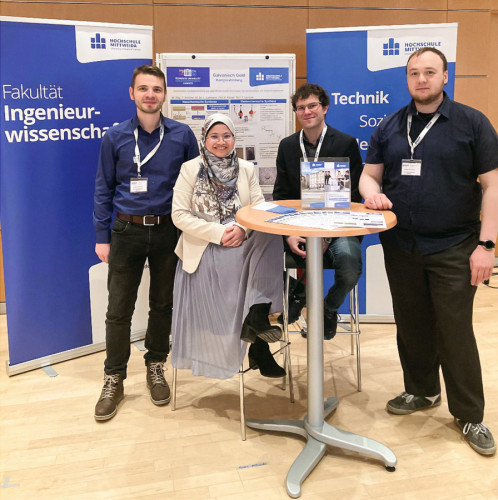 Surface technology working group: M. Eng. S. Dombrowe; M. Sci. N. Omar; Dr.-Ing. Näther, M. Eng. T. Schürer (from left to right). (Photo: HS Mittweida)Traditional surface engineering universities and colleges such as Ilmenau, Aalen and Chemnitz are well known. However, Mittweida University of Applied Sciences, the largest university of applied sciences in the state of Saxony with over 6,000 enrolled students, also plays a role in electroplating and surface technology. The five faculties offer the subjects of media, social work, industrial engineering, applied computer and life sciences as well as engineering in application-oriented and interdisciplinary teaching and research. The mechanical engineering course can be completed with the degrees Bachelor of Engineering (B. Eng.), Master of Engineering (M. Eng.) and Diplomingenieur (Dipl.-Ing (FH)). In addition to full-time study, the Bachelor's degree course also offers a dual study program. The Bachelor's degree focuses on digital product development, resource-efficient production technology, micromobility and laser and surface technology. In the Master's program, students can choose between digital product development/
Surface technology working group: M. Eng. S. Dombrowe; M. Sci. N. Omar; Dr.-Ing. Näther, M. Eng. T. Schürer (from left to right). (Photo: HS Mittweida)Traditional surface engineering universities and colleges such as Ilmenau, Aalen and Chemnitz are well known. However, Mittweida University of Applied Sciences, the largest university of applied sciences in the state of Saxony with over 6,000 enrolled students, also plays a role in electroplating and surface technology. The five faculties offer the subjects of media, social work, industrial engineering, applied computer and life sciences as well as engineering in application-oriented and interdisciplinary teaching and research. The mechanical engineering course can be completed with the degrees Bachelor of Engineering (B. Eng.), Master of Engineering (M. Eng.) and Diplomingenieur (Dipl.-Ing (FH)). In addition to full-time study, the Bachelor's degree course also offers a dual study program. The Bachelor's degree focuses on digital product development, resource-efficient production technology, micromobility and laser and surface technology. In the Master's program, students can choose between digital product development/
micromobility, resource-efficient production technology and surface technology. Students can acquire detailed theoretical knowledge of pre-, intermediate and post-treatment processes in surface technology in the Laser and Surface Technology specialization in the Bachelor's degree course and Surface Technology in the Master's degree course in Mechanical Engineering. In addition, students learn about processes for the deposition of metal layers and organic layers, which test methods are used to characterize the layers produced and which measures are required for the disposal or treatment of waste water, for example. The academic training is accompanied by numerous practical courses, e.g. practical work on a laboratory scale or in the technical center.
In addition to teaching, research also takes place at Mittweida University of Applied Sciences, including in the Surface and Electroplating Technology working group headed by Prof. Frank Köster, which focuses on product and process development. The working group is equipped with state-of-the-art equipment for pre-treatment processes (low and atmospheric pressure plasma, blasting cabin), metal deposition and powder coating. Deposited coatings can be characterized using SEM/EDX, X-ray fluorescence measurement, microhardness testing, optical microscopy, microsection preparation and wear and corrosion tests. Potentiostats, a rotating electrode and a quartz microbalance are available for electrolyte development.
We are currently working on 4 projects: Alternative corrosion protection and wear protection coatings to hard chromium coatings based on NiW alloy coatings or nickel-boron dispersion coatings, electroplatedReNi grid structures for modern X-ray applications as an alternative to cost-intensive gold grid structures, on the synthesis of cyanide-free gold salts for stable electrolytes for electroless and galvanic gold deposition and on more cost-effective PEM (polymer exchange membrane) electrolysis for hydrogen production by galvanically depositing iridum and iridium-ruthenium nanoparticles on the titanium anode carrier material. www.inw.hs-mittweida.de
INFO
Prospective electroplating technicians visit surface days
At the invitation of the ZVO, vocational students from the Gewerbliche Schule Schwäbisch Gmünd attended this year's Surface Days. Over 90 specialist presentations were offered in five lecture series. The association not only represents the interests of the industry in politics, but is also particularly involved in training and further education issues. The ZVO website offers extensive information on career prospects in electroplating and surface technology. New is the websitehttps://glanzvolle-karriere.de

